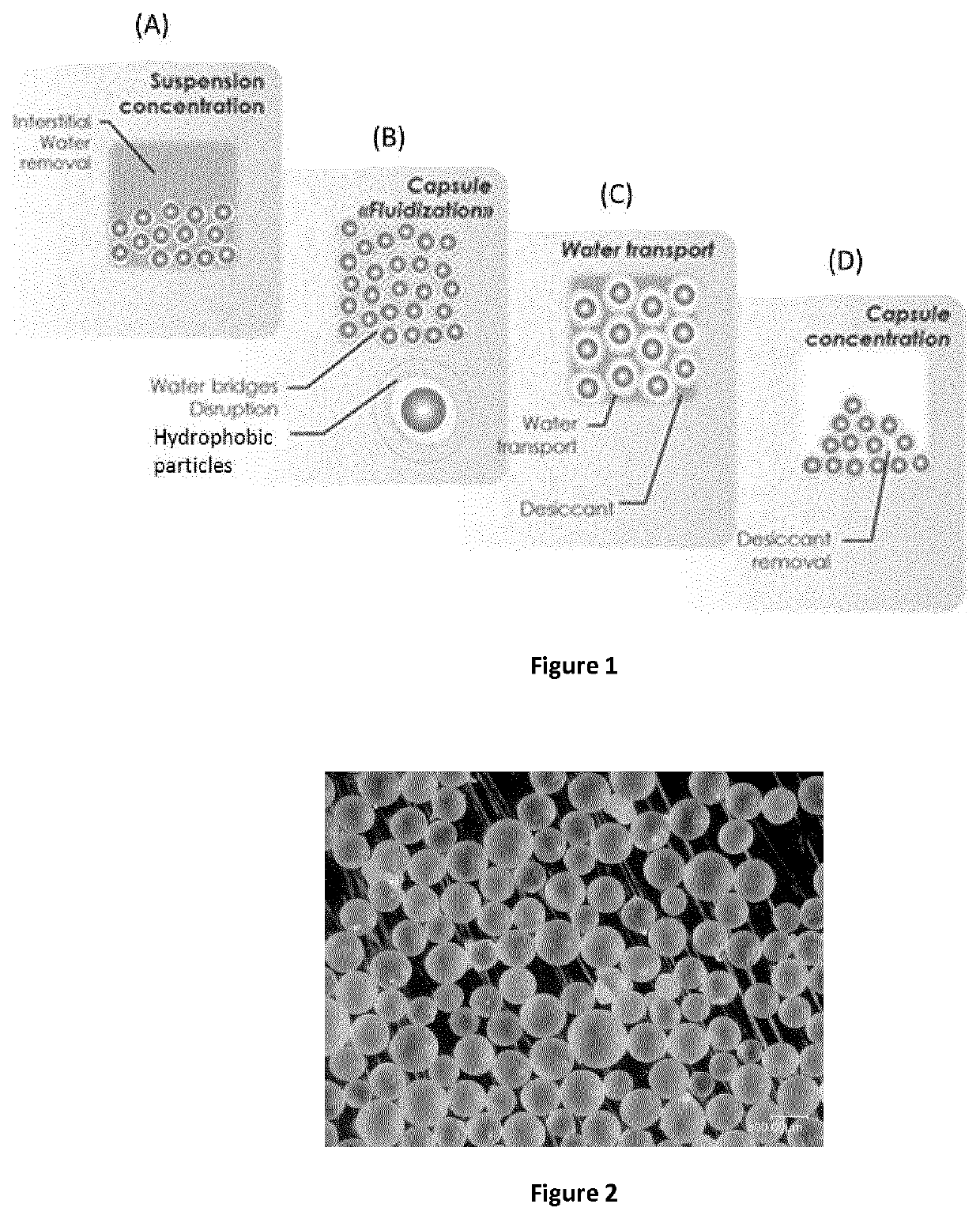Process for drying a suspension of hydrogel microcapsules
a technology of hydrogel microcapsules and hydrogel suspension, which is applied in the field of delivery systems, can solve the problems of volatile losses, encapsulation equipment, and relative rapid loss of olfactive benefits provided by active compounds due to their volatility, and achieve the effect of rapid loss of olfactive benefits
- Summary
- Abstract
- Description
- Claims
- Application Information
AI Technical Summary
Benefits of technology
Problems solved by technology
Method used
Image
Examples
example 1
Preparation of a Suspension of Core-Shell Microcapsules as Defined in the Present Invention
[0130]Aqueous solutions of 10% wt. pork gelatine (A) (250 Bloom, supplied by Norland), and 10% wt. gum Arabic (B) (Efficacia®, from CNI), are prepared separately.
[0131]In a vessel at 40° C., 25.4 g of solution (A) and 12.7 g of solution (B) are added to 92.8 g of warm demineralised water under mechanical shear. pH is adjusted to 4.5 using HCl 1M. The mixture is maintained at 40° C. during 15 min.
[0132]19.1 g of limonene oil is slowly added to the mixture and homogenised at 250 RPM during 5 min, so as to reach an average droplet size of 600 μm. Mechanical shear is maintained while the solution is let to cool down at 10° C. at a rate of 0.3° C.min-1. The stirring speed is slightly decreased, and 0.102 g of glutaraldehyde (aq.50% wt. Supplied by Sigma-Aldrich) is added to the mixture. Cross-linking is allowed to proceed during 4 to 10 hours at 20° C. The result is an aqueous suspension of microca...
example 2
Preparation of a Suspension of Core-Shell Microcapsules as Defined in the Present Invention
[0133]Solution (A′) is an aqueous solution of 10% wt of warm water fish gelatine (230 Bloom, supplied by Wheishardt). In a vessel at 40° C., 25.4 g of solution (A′) and 12.7 g of solution (B) (as prepared in example 1) are added to 92.8 g of warm demineralised water under mechanical shear. pH is adjusted to 4.5 using HCl 1M. The mixture is maintained at 40° C. during 15 min.
[0134]19.1 g of limonene oil is slowly added to the mixture and homogenised at 250 RPM during 5 min, so as to reach an average droplet size of 600 μm. Mechanical shear is maintained while the solution is let to cool down at 10° C. at a rate of 0.3° C.min-1. The stirring speed is slightly decreased, the pH is adjusted to 4.5 and 1.01 g of transglutaminase (ACTIVA® WM supplied by Ajinomoto) is added to the mixture. Cross-linking is allowed to proceed during 10 hours at 20° C. The result is an aqueous suspension of microcapsul...
example 3
Preparation of a Suspension of Core-Shell Microcapsules as Defined in the Present Invention
[0135]Solution (A′) is an aqueous solution of 10% wt of warm water fish gelatine (230 Bloom, supplied by Wheishardt). In a vessel at 40° C., 25.4 g of solution (A′) and 12.7 g of solution (B) (as prepared in example 1) are added to 92.8 g of warm demineralised water under mechanical shear. pH is adjusted to 4.5 using HCl 1M. The mixture is maintained at 40° C. during 15 min.
[0136]19.1 g of limonene oil is slowly added to the mixture and homogenised at 250 RPM during 5 min, so as to reach an average droplet size of 600 μm. Mechanical shear is maintained while the solution is let to cool down at 10° C. at a rate of 0.3° C.min-1. The stirring speed is slightly decreased, the pH is adjusted to 4.5 and 1.01 g of transglutaminase (ACTIVA® WM supplied by Ajinomoto) is added to the mixture. Cross-linking is allowed to proceed during 10 hours at 20° C. The result is an aqueous suspension of microcapsul...
PUM
| Property | Measurement | Unit |
|---|---|---|
| weight ratio | aaaaa | aaaaa |
| inlet temperature | aaaaa | aaaaa |
| inlet temperature | aaaaa | aaaaa |
Abstract
Description
Claims
Application Information
 Login to View More
Login to View More - R&D
- Intellectual Property
- Life Sciences
- Materials
- Tech Scout
- Unparalleled Data Quality
- Higher Quality Content
- 60% Fewer Hallucinations
Browse by: Latest US Patents, China's latest patents, Technical Efficacy Thesaurus, Application Domain, Technology Topic, Popular Technical Reports.
© 2025 PatSnap. All rights reserved.Legal|Privacy policy|Modern Slavery Act Transparency Statement|Sitemap|About US| Contact US: help@patsnap.com


